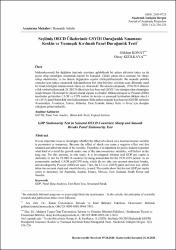| dc.contributor.author | Konat, Gökhan | |
| dc.contributor.author | Kızılkaya, Oktay | |
| dc.date.accessioned | 2022-04-08T11:49:24Z | |
| dc.date.available | 2022-04-08T11:49:24Z | |
| dc.date.issued | 2020 | en_US |
| dc.identifier.citation | Konat, G. & Kızılkaya, O. (2020). Seçilmiş OECD Ülkelerinde GSYİH Durağanlık Sınaması: Keskin ve Yumuşak Kırılmalı Panel Durağanlık Testi . Bitlis Eren Üniversitesi İktisadi Ve İdari Bilimler Fakültesi Akademik İzdüşüm Dergisi , 5 (2) , 216-226 . Retrieved from https://dergipark.org.tr/tr/pub/beuiibfaid/issue/57509/806819 | en_US |
| dc.identifier.uri | https://dergipark.org.tr/tr/pub/beuiibfaid/issue/57509/806819 | |
| dc.identifier.uri | https://hdl.handle.net/20.500.12899/949 | |
| dc.description.abstract | Makroekonomik bir değişken üzerinde meydana gelebilecek bir şokun etkisinin kalıcı ya da geçici olup olmadığını araştırmak önemli bir konudur. Çünkü şokun etkisi olumsuz bir etkiye sebep olabilmekte ve bu durum değişkenin seyrini etkileyebilmektedir. Bu nedenle politika yapıcılar için makro ekonomik değişkenlerden biri olan büyüme serisinin uzun dönemde nasıl bir trend izlediğini tahmin etmek önem arz etmektedir. Bu amaçla çalışmada, 1970-2019 dönemi yıllık veriler kullanılarak 28 OECD ülkesi için kişi başı reel GSYİH’nın durağan olup olmadığını araştırılmıştır. Ekonometrik yöntem olarak yapısal kırılmaları dikkate almayan ve Pesaran (2006) tarafından geliştirilen CADF ve CIPS testleri ile keskin ve yumuşak kırılmaları dikkate alan Li vd. (2015) panel birim kök testi kullanılmıştır. Elde edilen sonuçlar kişi başı reel GSYİH serisinin Avusturalya, Avusturya, Fransa, Meksika, Yeni Zelanda, Güney Kore ve İsveç için durağan olduğunu göstermektedir. | en_US |
| dc.description.abstract | It is an important issue to investigate whether the effect of a shock on a macroeconomic variable
is permanent or temporary. Because the effect of shock can cause a negative effect and this
situation can affect the trend of the variable. Therefore, it is important for policy makers to predict
what kind of a trend the growth series, one of the macroeconomic variables, will follow in the
long run. For this purpose, in this study, it is investigated whether real GDP per capita is
stationary or not for 28 OECD countries by using annual data for the 1970-2019 period. As an
econometric method, CADF and CIPS tests, which do not take into account structural breaks,
and developed by Pesaran (2006) are used. Then, the Li et al. (2015) panel unit root test, which
takes into account sharp and smooth breaks, is used. The results show that the real GDP per capita
series is stationary for Australia, Austria, France, Mexico, New Zealand, South Korea and
Sweden | en_US |
| dc.language.iso | tr | en_US |
| dc.publisher | Bitlis Eren Üniversitesi | en_US |
| dc.relation.ispartof | Bitlis Eren Üniversitesi İktisadi Ve İdari Bilimler Fakültesi Akademik İzdüşüm Dergisi | en_US |
| dc.rights | info:eu-repo/semantics/openAccess | en_US |
| dc.subject | GSYİH | en_US |
| dc.subject | Panel Veri Analizi | en_US |
| dc.subject | Birim Kök Testi | en_US |
| dc.subject | Yapısal Kırılma | en_US |
| dc.subject | GDP | en_US |
| dc.subject | Panel Data Analysis | en_US |
| dc.subject | Unit Root Test | en_US |
| dc.subject | Structural Break | en_US |
| dc.title | Seçilmiş OECD Ülkelerinde GSYİH Durağanlık Sınaması: Keskin ve Yumuşak Kırılmalı Panel Durağanlık Testi | en_US |
| dc.title.alternative | GDP Stationarity Test in Selected OECD Countries: Sharp and Smooth Breaks Panel Stationarity Test | en_US |
| dc.type | Article | en_US |
| dc.authorid | 0000-0002-3412-5616 | en_US |
| dc.department | MTÖ Üniversitesi, Sosyal ve Beşeri Bilimler Fakültesi, Uluslararası Ticaret ve Finansman Bölümü | en_US |
| dc.institutionauthor | Kızılkaya, Oktay | |
| dc.identifier.volume | 5 | en_US |
| dc.identifier.issue | 2 | en_US |
| dc.identifier.startpage | 216 | en_US |
| dc.identifier.endpage | 226 | en_US |
| dc.relation.publicationcategory | Makale - Uluslararası Hakemli Dergi - Kurum Öğretim Elemanı | en_US |


















